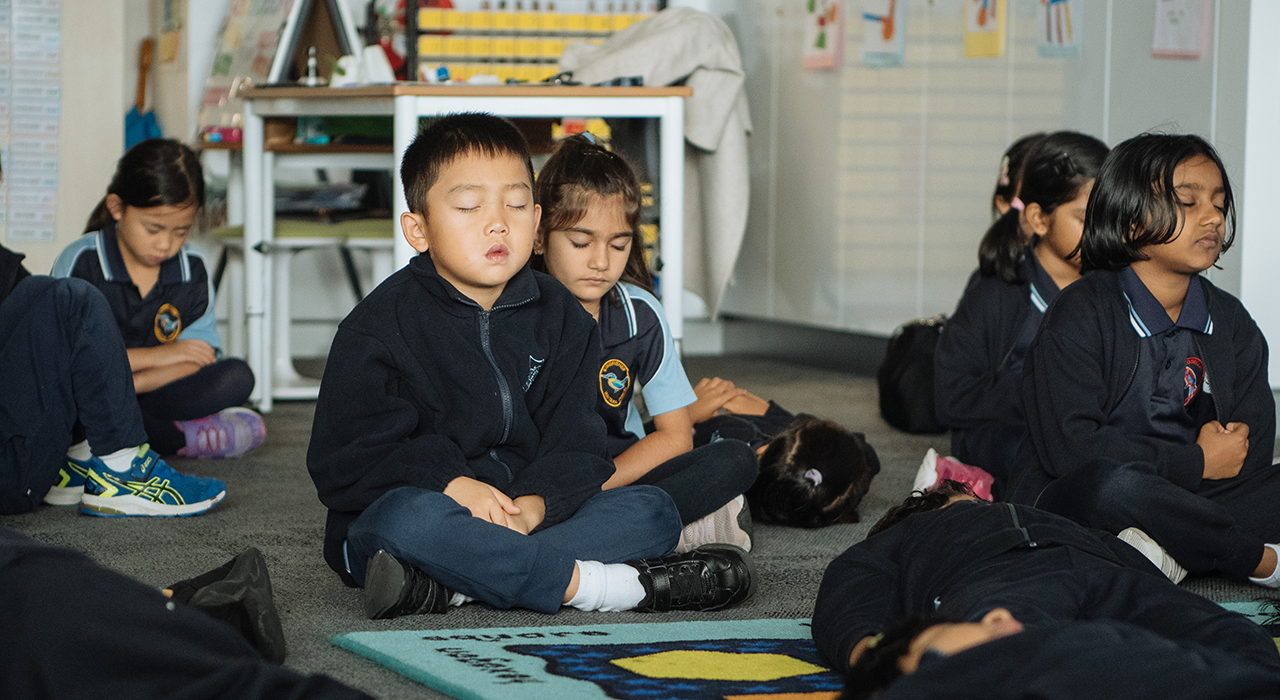“I think the reason we turn to journaling is to try and find answers that are already there,” explains Smiling Mind psychologist, Therese Sheedy. “We don't know that we have the power within, to heal ourselves. But, when we start to journal, we realise we do.”
Journaling is a great tool that anyone can use to encourage emotional expression and improve mental and physical health. Different from simply diary-keeping, Therese explains that although there’s “no one, standard way of journaling”, what it should be, is purpose-driven.
Guided by Therese’s professional experience and actionable advice, this piece will dive into how to journal for mental health and use its powers of self-discovery to improve your wellbeing.
Decide Your Journaling Goals
Identifying your overarching motivation for journaling is a great way to figure out how you’re going to tackle a session. By being clear about your intentions, you can help focus your thoughts, ease anxiety and start journaling with purpose.
Expression Journaling
Expressive writing can be used when you’re faced with confusing or stressful events and you need help sorting through the chaos. A guiding prompt here can be “how do I feel about this?”
Many choose to write or create in a steady stream of consciousness here, allowing anything and everything to come out. This free-flow style of journaling can help you express negative emotions, organise your personal thoughts and ultimately find clarity.
Prioritising Journaling
When you have multiple, conflicting situations, journaling can help you uncover how you feel about certain situations. Guide your journaling through a lens of: “What should I be focusing on? What’s most important to me right now?” This will help you more easily identify your priorities.
Processing Journaling
Process journaling is all about reaching a place of understanding.
“Some people try to get to a point where they’re completely rid of it, which is impossible,” explains Therese. “But, you can get to a point where you’re not triggered by it anymore.”
For this type of journaling, Therese suggests a more structured approach of daily sessions, approximately 20 minutes in length, for 3-4 days. The sessions should lead directly on from one another, and should all be inspired by the same journal prompts.
By using the same writing prompts every day, you give your mind permission to explore different avenues of thought in relation to the prompt. By doing so, you may realise emotions and thoughts unknowingly linked to the particular event that inspired your journaling in the first place.
The ultimate goal, says Therese, is to get to a place where you can think, “I can accept that this is an issue. I can accept that I've had those feelings, and I can still have those feelings. But I can be OK with those feelings.”
Gratitude Journaling
Gratitude journaling is all about shifting your mindset to be more present. By actively focusing on the good things that have happened in a day, week or general everyday life, you’re re-centering your thought patterns to be more positive.
Therese encourages people to take this one step further.
Gratitude is the receival of something that makes you happy. “It’s something you're receiving, whether it's somebody's generosity or somebody's kindness,” explains Therese.
“You (should) acknowledge where it's come from, as well as the impact for you. That’s the gratitude part.”
Keeping a gratitude journal not only places you in a more positive mindset, it also exercises your mental fitness. By doing so, you’re training your mind to be more adaptable, emotionally congruent and in the present moment.
Your Journaling Guidelines
Let go of perfectionism
“Journaling looks and feels different for everyone. I really encourage people to be free of judgement of their writing,” advises Therese. “We tend to think that journaling has to be very cognitive, and word ridden, but it doesn't have to be,”
Journaling can be a range of creative expressions, including but not limited to:
- Drawing
- Collaging
- Painting
- Sewing
- Making music
Journaling does not have to be confined to long slabs of prose, nor does it ever have to be shown to anyone else—colouring outside the lines and spelling mistakes are welcome here. If written word is your choice of journaling, using pen and paper comes with some remarkable benefits. Research has shown that the process of handwriting actually activates neural pathways in the brain that go near or through the parts of the brain that manage emotion.
Take a self-reflective angle
“Journaling is an exploration of self,” Therese says. It’s a place for acknowledging difficult emotions, personal growth and mistakes made. It’s important to allow your self awareness to grow through journaling, and this requires honest self reflection.
This ability to be honest and express self-awareness can take time and practise. Just like any other skill, it takes patience and consistency to become natural and for emotional healing to begin.
Ritualise it
Surround your journaling efforts with a routine. Think—same time, same duration, similar environment/s, and same habits in the lead up and the aftermath.
By adopting similar habits around your journaling, you’ll coach your mind to recognise this as part of your routine. By consequence, it will only become easier to honour that time by switching off and focusing on what you’re doing. This will help minimise unhelpful intrusive thoughts during your sessions.
Ritualising your journaling also helps you create comfort. By pairing journaling with small things that bring you joy, you foster a more safe, enjoyable atmosphere to approach the session. Small ways you can do to facilitate this comfort include:
- Making your favourite tea or drink
- Lighting candles or incense
- Settling into a favourite living space (at home or outdoors)
- Giving yourself tactile stimulation (e.g. a threaded blanket or pillow)
Don’t keep journals
We often think keeping a journal is simply a way to help us remember how far we’ve come. However, Therese warns of the possible negative impact this can have.
“You know how far you've come,” explains Therese. “Whereas if you go back and you read it, it can transport you into that space again. You may not be able to manage the trigger that (reading that) creates for you. You may not appreciate the actual journey you’ve gone through since then, and think that you're back there.”
This perceived lack of progress can be disheartening, explains Therese. However, she implores us to remember that “feelings come and go all the time. But, the situation is always different. Be kind to yourself—compassionate and notice your insights when you have them. But once you've written it, you don't need to keep it.”
Your Journaling Mindsets and Attitude
Journaling is all about identifying, acknowledging and processing emotions.
When journaling becomes a more consistent part of your routine, you’ll realise that emotions have a life-cycle, and that often you’ll experience them multiple times in your life. Sometimes, this can be deflating.
Here, it’s important to “understand that things do change,” advises Therese. We should focus on the why rather than the what when it comes to processing our emotions. Feelings will re-visit, however, the why we feel them, will change.
“Supportive self talk really helps you shift your perspective,” adds Therese. Positive internal dialogue allows you to shift into a more growth-oriented mindset, and adopt a self-reflective approach to your journaling. It’s here, your mental fitness comes into play. Through consistency and practise, this will strengthen and only become easier!
“If you can realise that you've got that (positive thinking) within you, I think that you know you're going to achieve what you want to achieve.”
Journaling prompts to get you started
The journaling prompts you use to guide and inspire your sessions make a big difference to the mindset you enter the session with. To boost mindfulness and orientate your journaling towards achieving improved wellbeing and growth, try using journal prompts like:
- What made you excited today?
- What are you most proud of?
- What made you feel differently this week?
- What was difficult this week and how did I react? How do I want to act moving forward?
Benefits of journaling
The physical health and mental health benefits of journaling have been documented for decades. For example, renowned psychologist, James Pennebaker (1986), found that people who included focused, journaling in their daily routine for just four days, already experienced positive effects like:
- Decreased mental distress
- Decreased levels of anxiety
- Better sleep and memory
- Improved work and social connectivity
More recently, Dr. Dan Siegel (2019) deepened the work of Pennebaker, finding that journaling actually allows the brain to enter a state of integration—the simultaneous activation of both hemispheres, allowing for better thought and emotional processing.
This integration, Siegel explains, allows people to experience a state of mind that’s more:
- Flexible and adaptive
- Resilient
- Emotionally consistent
- Energised
“Writing in a journal activates the narrator function of our minds. Studies have suggested that simply writing down our account of a challenging experience can lower physiological reactivity and increase our sense of well-being, even if we never show what we’ve written to anyone else.”
— Dr Dan Siegel
The act of journaling for your wellbeing goes beyond simply acknowledging an event. By providing your mind an outlet to explore and process emotions, you can experience a range of mental and physical health benefits, including lower stress and higher cognitive flexibility.
By taking on Therese’s advice of approaching journaling with purpose, positive self-talk and compassion, you’ll already be well on your way to improving your overall well being, and strengthening your mental fitness.
Interested in learning more about mental fitness and how it plays into your everyday life?


.jpg)








.jpg)





